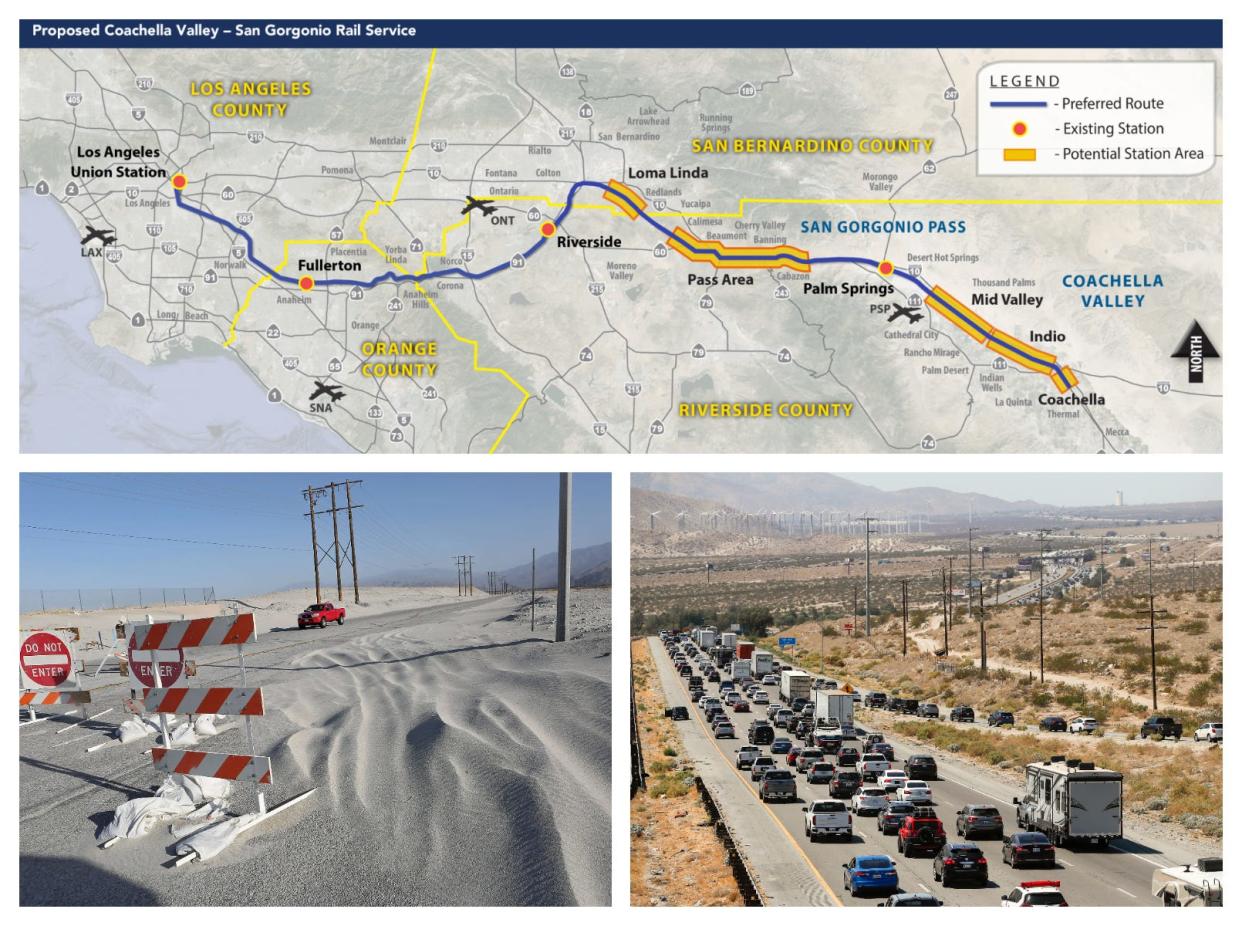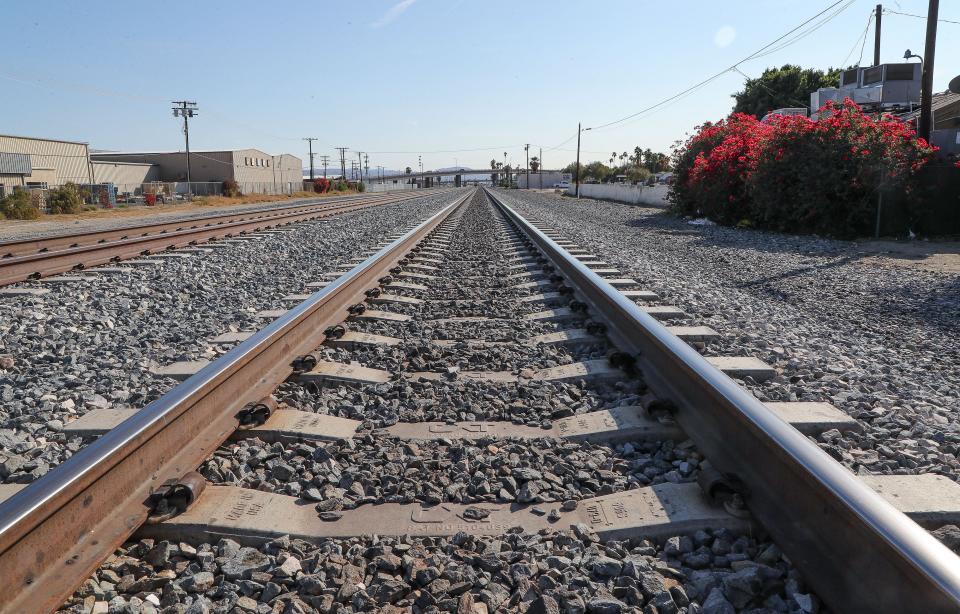Sales tax hike would fund road, bridge, rail plans in Coachella Valley. Voters may decide

Plenty of transportation projects in the Coachella Valley — ranging from new bridges along oft-closed roads to daily rail service connecting with Los Angeles — are in the works, but they all face the same roadblock: Is there enough money?
Voters in the valley — and throughout Riverside County — may offer an answer in the November election, as local officials are considering whether to place a countywide 1% sales tax measure on the ballot that would generate billions to address transit needs across the growing region.
The one-cent-per-dollar tax measure is slated for consideration by the Riverside County Transportation Commission during its meeting June 12. To go on the ballot, the proposal will require two-thirds approval from the commission, which includes a council member from each of the county’s 28 cities, along with the county’s five elected supervisors and one person appointed by the governor.
The proposal, if approved by voters, is estimated to generate roughly $25 billion over the next 30 years, including $5 billion in the Coachella Valley. The exact lifespan of the measure has not yet been finalized, but it would be in addition to the existing Measure A, a half-cent sales tax first approved by Riverside County voters in 1988 and extended in 2002 through 2039.
The measure has been discussed for several years by local transportation officials, with Riverside County projected to add another half-million residents to its population by 2050. It comes after RCTC members recently approved a new version of its traffic relief plan, which identifies key projects across western Riverside County, the Coachella Valley and the Blythe area.
As it stands, the ballot proposal will need approval from two-thirds of voters to take effect, and it could be a close race: Polling conducted by RCTC last year found 67% of Riverside County voters were initially supportive of a new funding measure for local transportation projects. However, that two-thirds requirement could change: A statewide measure to lower the approval threshold for many local tax measures, including this one, from 66.7% to 55% will also be on the November ballot.
How much would taxes be?
The measure would raise the countywide sales tax from 7.75% to 8.75%. That's the rate that people pay on purchases in unincorporated areas or in cities that have chosen not to tack on their own surcharges.
That 8.75% rate would apply in Desert Hot Springs, Indian Wells, Palm Desert and Rancho Mirage. Four cities in the valley apply a 1% sales tax surcharge and would have a 9.75% rate if the new increase is approved: Cathedral City, Coachella, Indio and La Quinta.
In Palm Springs, where the city already imposes a 1.5% extra tax, the rate would go from 9.25% to 10.25% — the highest in Riverside County.
Where would the money go?
While the specifics of the measure won’t be finalized until the RCTC’s vote, the traffic relief plan identifies several key projects within the Coachella Valley that need funding, including a new bridge at Avenue 50, grade separations along Highway 86 and CV Link extensions to Desert Hot Springs and North Shore.

The proposal for daily rail service connecting the valley to Los Angeles, with an estimated price tag north of $1 billion, is also included in the RCTC plan. The plan also discusses building bridges for roads impacted by floods and blowing sands, such as Indian Canyon Drive and Dillon Road, as well as possible toll lanes on Interstate 10. (The region has already won a state grant to cover most of the cost of bridges along Indian Canyon Drive.)
“We want to make sure that infrastructure that seems to be impacted by natural disasters can be fixed so that residents have greater access to move through the Coachella Valley,” David Knudsen, RCTC’s external affairs director, said in an interview.
More: Where will LA-to-Coachella train stop? Valley cities start eyeing spots for stations
Any tax revenue created by the measure would stay in the region, as the Coachella Valley Association of Governments — which includes representatives from each of the valley’s cities, as well as local tribal groups — would oversee the funding locally.
La Quinta City Councilmember Kathleen Fitzpatrick, who serves on the RCTC and CVAG’s transportation committee, said ensuring the measure has a “strong local focus” is more important than picking out specific projects at this point in the process.
“One of the things that, if this were to go on the ballot, we're assured (of) is that we don't lose local control over what projects actually get done with the money that's returned to the valley,” Fitzpatrick said.
The proposed setup has also drawn questions. Fitzpatrick said La Quinta wants to keep control of its pavement management plan, noting the city has spent roughly $16 million on road upgrades in recent years. City officials in Rancho Mirage have also raised concerns over the potential measure’s funds only going to CVAG, rather than to the cities that manage the roads.
A regional approach
CVAG Executive Director Tom Kirk said in an interview that his discussions with city officials have been positive. Under the proposal, cities would continue to oversee smaller roads within their boundaries, while more regional roads such as Highway 111 or Bob Hope Drive would be managed by CVAG — a setup that Kirk says would bring benefits across the board.
“It costs more to do smaller projects, and it’s really frustrating for those of us that live here,” Kirk said. “You’re driving along a roadway (under construction), and you swear you were just driving along this roadway as it was being fixed. It was, but the next city didn’t coordinate the work with the first city.”
“We would really want to streamline that process and get the roadwork done at the right times of year and the right times of the day, and (we're) trying to do it in a cost-effective way, which means doing it regionally,” Kirk said, adding that it would be similar to how cities and CVAG already divvy up responsibility for street sweeping.
Additional analysis could also mitigate those cities’ concerns. Earlier this month, the CVAG Transportation Committee authorized roughly $246,000 to study next steps for a regional pavement management program for the valley’s main arteries. That review will include finding ways to make sure all cities benefit from the valley-wide approach.
It remains to be seen what kinds of support or opposition groups might form if the ballot measure goes on the ballot, though Fitzpatrick said she expects some proponents to come from the valley’s business community. City councils could also weigh in on the measure, though Fitzpatrick said the council in La Quinta likely won’t take a position.
"This is to try and stay ahead of the game," Fitzpatrick said of the discussion. “There was strong support in 2019 and 2020 for a measure like this. We'll see when they do the public outreach, when the ordinance is drafted, whether there's still strong support.”
“But I think it would be naïve to think that we don't need improvements, and those improvements are much more costly than they've ever been in the past,” she added. “The money's got to come from somewhere.”
Tom Coulter covers the cities of Palm Desert, La Quinta, Rancho Mirage and Indian Wells. Reach him at thomas.coulter@desertsun.com.
This article originally appeared on Palm Springs Desert Sun: Voters may decide on 1% sales tax hike in Riverside County

